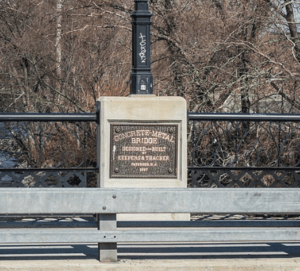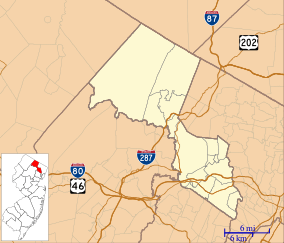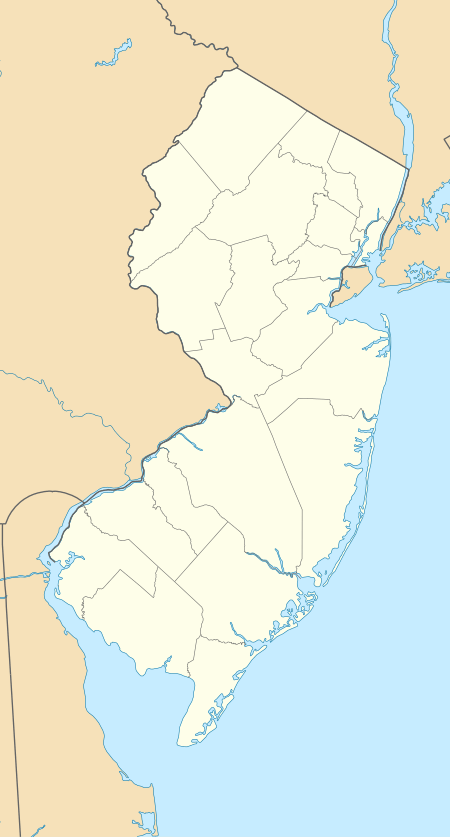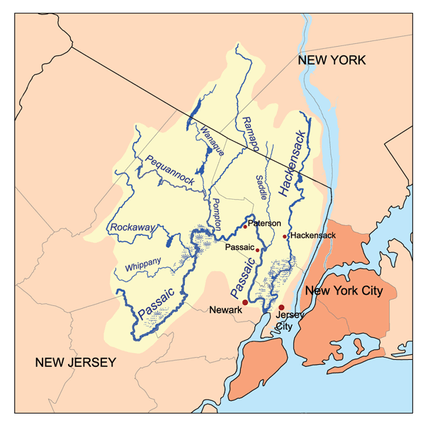West Broadway Bridge
The West Broadway Bridge, aka West Street Bridge and the Concrete-Metal Bridge, is a vehicular bridge over the Passaic River in Paterson, New Jersey. It carries West Broadway (CR 673), traditionally the Paterson-Hamburg Turnpike, and connects to County Route 509 at its west end.
West Broadway Bridge | |
|---|---|
 | |
| Coordinates | 40.9211°N 74.1751°W |
| Carries | Paterson-Hamburg Turnpike West Broadway County Route 509 CR 673 |
| Crosses | Passaic River |
| Locale | Paterson, New Jersey |
| Other name(s) | West Street Bridge Concrete-Metal Bridge |
| Owner | Passaic County |
| Maintained by | County |
| ID number | 1600017[1] |
| Characteristics | |
| Design | Melan-type arch bridge |
| Material | steel/concrete |
| Total length | 290 feet (88 m) |
| Width | 35.4 feet (10.8 m) |
| Longest span | 86.9 feet (26.5 m) |
| No. of spans | 3 |
| History | |
| Designer | Edwin Thacher |
| Construction end | 1897 2004 rehab |
| Opened | 1897 |
 West Broadway Bridge Location in Passaic County, New Jersey  West Broadway Bridge West Broadway Bridge (New Jersey)  West Broadway Bridge West Broadway Bridge (the United States) | |
| References | |
| [2][3][4][5][6][7] | |
The bridge was built in 1897 and restored in 2004. The flood of 1903 caused damage or destruction of most bridges in the vicinity of Paterson; the West Street bridge survived with serious damage.[8][9]
The bridge is considered a nationally significant example of the Melan arch bridge technology and one of earliest and the most important concrete-steel spans in the Northeast. A historic bridge survey conducted by NJDOT from 1991–1994 determined that the bridge is eligible for listing on the New Jersey Register of Historic Places and the National Register of Historic Places. In March 1997, the State Historic Preservation Office concurred (NJRHP #3959).[10]
.jpg)
See also

- Arch Street Bridge
- Straight Street Bridge
- List of crossings of the Upper Passaic River
- List of crossings of the Lower Passaic River
- List of crossings of the Hackensack River
- List of county routes in Passaic County, New Jersey
- Melan Bridge
- Passaic River Flood Tunnel



References
- "Bridge Statistics for Paterson, New Jersey (NJ)". www.city-data.com.
- "Historic Bridge Survey (1991-1994)" (PDF). NJDOT. 2001. Retrieved 14 November 2016.
The handsome, well-proportioned 233'-long, 3-span, Melan steel and concrete elliptical arch bridge has coursed brownstone ashlar-faced spandrel walls and cutwater piers. They are backed by concrete. It is 54'-wide and carries a 2-lane city street flanked by wide sidewalks enclosed by metal railings with lattice panels on the bottom. The railings were installed in 1937 replacing the original. Each of the cinder-filled arch spans is approximately 89' long, and the rise is 9.5'. The bridge is built on the Melan system with 10" I-beams set 3' on center and embedded in concrete that varies in thickness from 15" at the crown to 66" at the skewbacks. Expansion joints are built in the spandrel walls over the piers to provide for thermal changes. The southernmost two spans were damaged in the 1903 flood and were repaired in kind at that time. The bridge is well preserved...When completed in 1898, the handsome elliptical arch bridge was the second longest Melan- type bridge in the country, ranking after a similar span in Topeka, Kansas completed in 1896-97. Industrial Historian Donald C. Jackson states that the Topeka bridge, completed about one year before the similar arch at Paterson, was the "first major reinforced concrete arch bridge in the United States" (p. 35). Thacher's bridge at Paterson is one of the most important concrete-steel spans in the Northeast based on its date, structural type, and remarkably complete state of preservation (criterion C). It is a nationally significant example of the Melan arch bridge technology, and it was designed by noted civil engineer Edwin Thacher. Thacher was a proponent of the Melan arch which is a series of parallel iron or steel I-beams curved to the profile of the soffit and encased in plain concrete. Joseph Melan, a Viennese engineer, was granted an American patent for his design in 1894. Fritz von Emperger, a German-born engineer, built the first Melan arch in the United States at Rock Rapids, Iowa, and he is credited with popularizing the design in this country. Emperger made additions to the Melan system, adding a beam to the deck and joining the deck and arch beams by means of bars set on radial lines. He was granted a patent in 1897 for the changes to Melan's patent...Edwin Thacher and William Mueser formed the Concrete-Steel Engineering Company in New York City in 1901, and the firm was responsible for many important Melan-type bridges in the country, including the 8-span Grand Avenue Viaduct, Milwaukee, Wisconsin, built in 1907; a 7-span Melan arch built at Wichita, Kansas, built in 1911; the 6-span Hudson River bridge at Glens Falls, New York, built in 1914-15; the bridge over the Mississippi River at Minneapolis composed of five 231' spans built in 1907. Thacher was a versatile engineer who received many patents including one for the "Thacher Cylindrical Slide-Rule," the "Thacher Steel Bridge Truss," the "System of Concrete Steel Arches," and the "Thacher Combination Bridge Truss" among others. He held positions of chief engineer for the Decatur Bridge Company of Decatur, Alabama, and the Keystone Bridge Company of Pittsburgh before opening his own consulting firm in Louisville, Kentucky. He was responsible for the 1891 Walnut Street bridge across the Mississippi River at Chattanooga and the 1892 Costilla Crossing bridge over the Rio Grande in Colorado which was an example of the Thacher truss patented in 1884 and designed to reduce the effect of temperature stresses on truss members. Thacher formed a partnership with W.H. Keepers in 1894 at Detroit, and the partnership lasted as Thacher and Keepers until October of 1899. It was this firm that designed the West Broadway bridge at Paterson. Thacher remained with the Concrete-Steel Engineering Company until his retirement in 1912. The Melan arch was replaced in popularity in this country by the reinforced concrete arch span...The Thacher & Keepers-designed Melan-type arch bridge is one of two in the state designed by Edwin Thacher. The other is located in Branch Brook Park in Newark (Essex County) (0700101). It was designed by the Concrete-Steel Engineering Company in 1905. Both are technologically and historically important as examples of the experimentation associated with the introduction of concrete and steel arch bridges in this country.
- "New Jersey and National Registers of Historic Places". NJ DEP - State Historic Preservation Office. Retrieved 28 November 2016.
- "County Routes" (PDF). Passaic County.
- "Passaic County Road System". Passaic County. 2001.
- "West Broadway Bridge". Retrieved 26 October 2016.
- Mahmoud, Khaled (2015), Sustainable Bridge Structures: Proceedings of the 8th New York City Bridge Conference, 24-25 August, 2015, New York City, USA, CRC Press, ISBN 9781315657837
- Ensslin, John C. (September 2, 2011). "1903 flood still ranks as North Jersey's worst". The Record. Retrieved 14 November 2016.
- Leighton, Marshall Ora (1904). "The Passaic Flood Of 1903" (PDF). Government Printing Office. p. 23. Retrieved 9 November 2016.
The bridges crossing Passaic River in Passaic, Essex, and Bergen counties were almost completely destroyed, and the damage amounted to $654,811. Within the limits of Paterson, below Great Falls, all of the highway bridges except two were either severely damaged or completely carried away. West street bridge, the first below the falls, was a Melan concrete, steel-arch structure, built in 1897, and costing $65,000. It was composed of three spans, each about 90 feet long. The flood practically split two spans longitudinally, the upstream side of each, equal to about one-third of the width of the bridge, being carried away. This structure was built to conform to the established grades of streets on both sides of the river and was completely inundated, forming a barrier for floating débris and practically making a dam in the river. Main street bridge is a 3-span, steel-arch structure, which was completely covered during the flood, but was only slightly injured. Arch street bridge, built in 1902 to take the place of a structure carried away by the March flood, was a concrete-arch bridge of three spans. It was undermined at the north pier and collapsed, being practically destroyed. The original cost of this bridge was $34,000. Its piers presented a serious obstruction to the flow of the stream, especially as the channel is very narrow at this point. In addition to this, the bridge was of low grade and admirably adapted for deterring flood flow. Below Arch street bridge all the other structures crossing the Passaic were of iron and were carried away, with the exception of Sixth avenue and Wesel bridges. Those destroyed were designated as follows: Straight street, Hillman street, Moffat, Wagaraw, Fifth avenue, East Thirty-third street, and Broadway bridges. All these structures were built too low, and were inundated during the early stages of the flood.
- Zamiskie, G.; Chiara, J. (2015). "Rehabilitation of the West Broadway Bridge over the Passaic River, Paterson, New Jersey". Sustainable Bridge Structures. pp. 315–328. doi:10.1201/b18775-36. ISBN 978-1-138-02878-4.